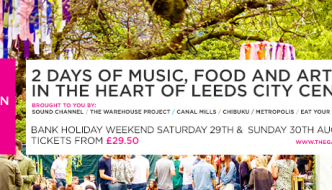Review: ‘The Hirstian pact; Boho or Boohoo?’
January 22, 2015
On a black mid-winter night, I joined a select assembly of Leeds’ art enthusiasts, scuttling moth-like toward the Tetley’s neon-scribbled façade. We’d gathered to hear a lecture from Glyn Thompson, Damien Hirst’s teacher turned-art historian, following an exhibition exploring Hirst’s earliest work at Jacob Kramer College; the premise of each being a stage-redressing in advance of the artist’s forthcoming (ghost-written) autobiography.
We were promised an ‘old-school’ lecture: no laptops, no PowerPoint – no talking! Lights down, shut up, listen. On flickered the projector, into the carousel slid the slides. He began with a hefty question.
Is Hirst merely the personification of the bohemian stereotype?It was hastily divided and subdivided. What did he and his contemporaries understand by ‘bohemian’? Did they identify with this idea? Is it a stable term – does it refer to actual events, people, a specific time and place? He blurred our focus, rapidly contrasting images of art and artists from bohemianism’s many gilded ages: late-19th Century Paris, early-20th Century Vienna, New York in the 50s and 60s – from Degas, Van Gough, to Shiele and Klimt, to Warhol, to Pollock – from the surrealists, to Dadaism, the impressionists, expressionism, to fauvism and symbolism, post-modernism, the Beats. The Proper Names, -ists and -isms flew by with dizzying speed as he accelerated his tour of ‘boho’ tropes: tortured geniuses, bordering on madness; poverty-stricken, drug-addled sexual deviants; dangerous outsiders; central-European gypsies, the original ‘Bohemians’.
[La bohème © G. Ricordi & Co.]
The bohemian ideal was portrayed as wistfully nostalgic. A hangover from pre-1700, pre-Academy notions of painters and sculptors as craftsmen, guild members, paid accordingly – very little. Propelled to the 1890s, to Paris’ seedy underworld – distilled in Puccini’s La bohème and Lautrec’s swirling visions of the Moulin Rouge – we saw how this reality evaporated long before it reached Opera Houses and the Musée d’Orsey. We heard how its heady miasma drifted from Vienna to Munich, to New York’s So-Ho, to Williamsburg, to London’s Hoxton and Shoreditch, driving property booms, shaping fashion, advertising and youth culture. We were delivered a neatly packaged history of an idea, propagated by novelists and the media, whose speculations about the lives of artists and their cohorts gave rise to the bohemian narrative.
It would be tempting to criticize Thompson’s breathless pace and erudition. Open to all in name only, his lecture was not for the uninitiated.But as the art-conceptual abstractions stacked higher, it became clear we were intended to cower in their shadow. He’d helped us imagine how he conjured bohemianism’s ghostly presence: a hollow spectre, all guff and gas, suffocating his students. He gave an outline of the vacuum that Hirst apparently filled. Hirst embodied a belated punk’ persona. He derided his mentor, Patrick Oliver, as a ‘romantic bohemian cliché’ – an inflated aesthete, worth a pop. This offers a revealing context to think about his work. We see Pharmacy less as a headline bating, categorical provocation – Where’s the art? – more as a sterilised trope, self-medication, in naked isolation. We see bohemian preoccupations, stripped of desire and romance, methodically dissected: mortality, transcendence, rebirth.
[For the Love of God © Fabian Castanier Gallery]
Thompson read from Hirst’s adolescent essay on art economy, ‘Why cunts sell shit to fools’. We were given Hirst’s blunt syllogism: ‘(1.) The fools behave like they are supposed to – like fools! (2.) Because of (1.) then the cunts come out of the woodwork and make a killing! But that’s not the whole of the story, this scenario – points (1.) and (2.) work together as a force (3.). Which in turn creates a decline in quality.’ We wonder what angsty, teen Hirst would have thought about his career’s trajectory, of Charles Saatchi’s multi-million pound patronage; of the contemporary debates surrounding the art market which his own work largely initiated. This alerts us to self-reflective scrutiny in his later work, his diamond skull its apex.
At the lecture’s close, it seems the best that Damien Hirst did, very successfully, was critique artistic value. How did Thompson feel about this? The discussion was aborted in favour of questions at the bar. Which was a shame. Without a Q&A, or a guest respondent, the event was lopsided. I expected a bit more than a taste of Hirst’s education – what kind of student was he? Who did he identify with? We were left with the impression he was less blindly provocative, more self-aware, but still, at worst, quite flat and monotropic, subsumed by art criticism and an art-monetising elite. But to Thompson’s credit, his lecture was rigorously true to its brief: oppressive, forceful, delivered at lightning speed, drawing on an encyclopedic range of sources, and bustling with witticisms and revealing anecdotes – a worthwhile conclusion to Educating Damien* *and others.
George Cooper
Glyn Thompson’s lecture ‘The Hirstian Pact; Boho Or Boohoo?’ took place at The Tetley on Thursday 8th January 2015.






Comments